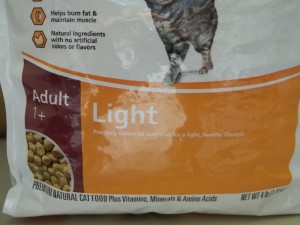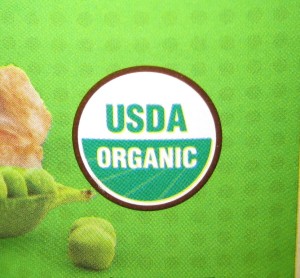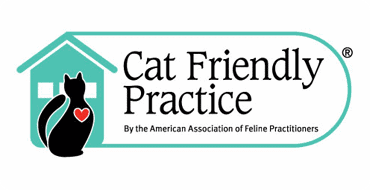Do you ever feel bombarded by advertising as you walk down a pet food aisle? Food companies put a lot of effort into making their food bags catch your eye, and putting wording on the front to make you believe their food is the best option for you. Words like “premium”, “super premium”, “ultra premium”, “gourmet”, “holistic”, “organic”, “natural”, “low-fat”, “weight management”, “low-calorie” are everywhere. The list goes on and on. Do those words actually mean anything, or are they just there to suck you in?
Well, our friends at AAFCO have defined some of these terms so that they do have meaning. If you want your pet to lose weight, you should look for the terms “Lite”, “Light”, or “Low-calorie”. These terms have been defined to contain less than a specified amount of calories per pound of food. The terms “Lean” and “Low-fat” are defined to have less than a specified amount of fat. The bottom of this FDA page lists those amounts for wet and dry foods.
Other dieting terms such as “Weight Management” or “Weight Control” have no AAFCO definition. They may have fewer calories than the same brand’s regular maintenance diet, but could have a much higher calorie content than “Light” foods. Not all foods list the calorie content on the food bag, so knowing these terms will be helpful when trying to pick out a food for weight loss. Also make sure the AAFCO statement reads that the food is adequate for maintenance of adult dogs, not “all life stages” (See Part 1 of this series).
The term “Organic” refers to the handling and processing of ingredients and products, avoiding pesticides and fertilizers. If you are looking for an organic pet food, look for the USDA Organic seal. This ensures that the pet food is made with >95% organic ingredients. Other organic labels you may see are usually trade associations, and their requirements may not be as stringent as the USDA’s.
The term “Natural” is not defined by AAFCO. It is generally used to indicate that there are no artificial flavors, colors, or preservatives in a food, and AAFCO has created guidelines for what types of foods should be considered natural. However there are no regulations controlling what foods are labeled as natural.
Terms such as “Super-premium”, “gourmet”, or “holistic” have no definition and are just there to catch your eye. Also keep in mind that there is no regulation on what companies can put on their website, so always look at the pet food label to get the information you need.
You may also be interested to know that the name of the food itself can give you a clue as to how much of a certain ingredient is in the food. Since many people choose their pet food based on the name, AAFCO has created four rules for naming foods based on the percentages of the main ingredients in the food.
1. The 95% Rule: Refers to the percentage of meat, poultry, or fish in the product (not grains). For example a food named “Chicken Dog Food” would have to contain at least 95% Chicken by weight.
2. The 25% Rule: These foods have between 25-95% meat, and have terms such as “Dinner”, “Entrée”, “Platter”, or “Formula” in the name. So a food named “Tuna Entrée” would contain between 25 and 95% Tuna. For a food named something like “Chicken and Liver Formula”, the total weight of the chicken and liver together must be between 25 and 95% of the food.
3. The 3% Rule or “with” Rule: A food that says “with Beef” must contain at least 3% Beef.
4. The “Flavor” rule: This is a vague rule, there is no required percentage, but there must be enough of the ingredient in the product to be recognizable by the pet. These foods will have “flavor” in the name of the product, such as “Tuna Flavor Cat Food”.
For more details you can go to this FDA webpage, and look under Product Name. The main point to keep in mind is that a food called “Chicken Cat Food” will have a lot more chicken in it than one called “Cat Food with Chicken”.
Hopefully some of these guidelines help you sort through that daunting pet food aisle. Keep in mind that all these companies are trying to sell you their food, so to find a quality diet you have to look past the flashy packaging and see what that bag really says.
So considering everything we’ve discussed in these last 3 posts, how do you pick the right pet food for your pet? I would start by deciding ahead of time what you are wanting from the food. Do you want a food that will help with skin health or dental health? Do you want to feed a particular type of meat? Is it important to you to have a grain-free or natural food (keep in mind there are no scientific studies to show these foods are better than others)? This can help narrow down your options. You can look at the ingredient list to see what types of ingredents are in the bag. The packaging can tell you whether a food is organic or a “light” diet. And always check the AAFCO statement to see if the food has been through feeding trials (see Part 1 of this series).
If you’re up for doing a little more research, you can contact the pet food manufacturer for more specific information. Pet food manufacturers are required to list their name and address on the packaging. Some will also list their phone number which is a good indicator that they are interested in helping the people who buy their foods. If not, here is a list of most pet food manufacturers. Ask them whether their food was formulated by a veterinary nutritionist, or what measures they take to ensure quality control (i.e. How do they avoid recalls for Salmonella contamination?). They should be able to tell you how many calories are in a cup of their food. The more open a company is about their processes, the more likely it is that you can trust that they are providing a quality food. Here is a great resource from the World Small Animal Veterinary Alliance on questions you can ask your pet food manufacturer: WSAVA Questions for Manufacturers. If the manufacturer cannot answer these questions you should be wary of feeding their food to your pet.




